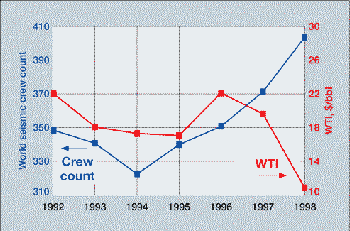What's happening in exploration
Will seismic business continue to boom?Clearly, the use of seismic has dramatically increased since the late 1970s. This increase occurred because geo-scientists and managers found that seismic data usually more than pays for itself. Marketed under the "increase costs and save money" banner, 3-D seismic, even when combined with expensive processing such as pre-stack depth migration, appears to be cost-effective. But is there a limit to the growth, or at least growth rate, of seismic? The next year or two will answer that question, as an ample supply of seismic capacity comes online, amid the backdrop of continuing low oil prices. PGS and Veritas reported healthy increases in income and revenues for their most recent quarter. Geophysical revenues were flat for CGG, while its equipment sales increased 19%. Input / Output, a seismic equipment manufacturer, announced that it expected earnings for the quarter ending Aug. 31 to be substantially below both market expectations and the corresponding period last year. However, last year's earnings and revenues set record highs for the company.
Another seismic supplier, Geoscience Corp., reported record revenue increases for the quarter ending June 30. The company, parent of Syntron, said most of the increase is attributable to shipments in seismic acquisition equipment. No doubt, much of this equipment will supply the current and future seismic shipbuilding frenzy. Some highlights of vessel frenzy follow. Shipbuilder Mjellem & Karlssen (M&K) has been very busy lately. After christening the SRV Veritas Viking in June, the company has another viking-class vessel in the works, due out by spring 1999. Veritas plans to add a vessel each year to its fleet. Geco-Prakla contracted M&K to build what it claims is the world's largest capacity seismic vessel, in terms of footprint. The 312-ft ship will have 20-streamer capacity with a 1,120-m spread, and is due in March 1999. Geco recently finished converting one of the world's largest fishing vessels, the American Champion, to seismic duty. Renamed Triton, the ship was initially fitted with ten 6,000-m streamers with a 1,100-m spread. PGS signed a contract for its fifth Ramform vessel, the Ramform Victory. The Victory will have a 20-streamer capability, and is scheduled for delivery first quarter 1999. Fugro-Geoteam AS will convert an 82-m vessel into its fleet this year. The Geo-Pacific will have four-streamer capability, each 4,000-m long. Not to be outdone, Western has two new vessels under construction, each with 12-streamer capacity. Delivery dates from builder Ulstein Verft AS are March and November 1999. Newly formed Aker Geo should have its first vessel in operation by summer 1999. The company has ambitious plans to expand its fleet to six vessels within three-to-five years. Nopec International will place two more ships in service later this year, expanding its fleet to four. Eagle Offshore is currently outfitting a four-streamer vessel for seismic duty, and is building what is perhaps the longest commercial seismic vessel, the Atlantic Horizon. At 400 ft, the ship will tow up to ten, 8,000-m streamers, and should be operational by year's end. Will the current buildup create excess capacity? No one knows, but one thing is certain — 'it's a good time to be in the seismic shipbuilding business. Microseismic survey. CGG Borehole Services Division, in partnership with CSM Associates Ltd., recently completed a large, passive seismic survey offshore Denmark. A reconfigured seismic receiver was placed in a retired well to monitor signals arising from nearby producing wells. These signals are typically several hundred hertz, a much higher frequency than is normally associated with seismic surveys. The receiver array was lowered to about 600 ft above the reservoir, hydraulically locked in place to assure good acoustic coupling, and then left for 60 days. Data from 18 channels was transmitted to the surface in real time, where processing may provide information on structures within the reservoir. Apache gas discovery. Apache
announced in August that its Rose-1 natural gas discovery offshore Western Australia tested
at a combined rate of 89 MMcfgd and 3,100 bcpd from three zones. The well was drilled to a
TD of 8,669 ft, with Triassic and Jurassic-age sandstone pays at depths between 7,705 and
8,403 ft. Copyright © 1999 World
Oil |
- Applying ultra-deep LWD resistivity technology successfully in a SAGD operation (May 2019)
- Adoption of wireless intelligent completions advances (May 2019)
- Majors double down as takeaway crunch eases (April 2019)
- What’s new in well logging and formation evaluation (April 2019)
- Qualification of a 20,000-psi subsea BOP: A collaborative approach (February 2019)
- ConocoPhillips’ Greg Leveille sees rapid trajectory of technical advancement continuing (February 2019)




